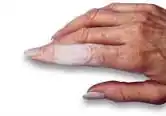Skin maceration

Maceration is defined as the softening and breaking down of skin resulting from prolonged exposure to moisture. It was first described by Jean-Martin Charcot in 1877.[1][2] Maceration is caused by excessive amounts of fluid remaining in contact with the skin or the surface of a wound for extended periods.
Maceration often occurs when one applies a bandage to everything from a paper cut on the finger to much larger wounds that require professional treatment. This occurs because the skin under the bandage becomes wet due to perspiration, urine or other bodily fluids. The excess moisture is sometimes called hyperhydration.
One may also notice maceration after wearing non-breathable plastic or latex rubber gloves, which trap moisture against the skin.
Wrinkles are the first sign that the skin is over-hydrated. In addition, macerated skin becomes extremely soft and takes on a whitish appearance. However, this white skin should not be confused with the pale, whitish appearance of the new epithelial tissue in a healing wound.
.jpg.webp)
Although most maceration clears up quickly once the skin is exposed to fresh air and allowed to dry, sometimes skin that experiences long periods of maceration is vulnerable to fungal and bacterial infection. As opportunistic organisms affect the area, it may become itchy or develop a foul odour.
References
| Look up prune in Wiktionary, the free dictionary. |
- ↑ Cutting, Keith (1 November 2001). "The causes and prevention of maceration of the skin". Nursing Times. Archived from the original on 3 January 2020. Retrieved 1 August 2015.
- ↑ Cutting, Keith; White, Richard (July 2002). "Maceration of the skin and wound bed. 1: Its nature and causes". Journal of Wound Care. 11 (7): 275–278. doi:10.12968/jowc.2002.11.7.26414. Archived from the original on 20 February 2016. Retrieved 11 December 2015.